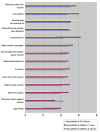Influenza vaccination among household contacts of children with cystic fibrosis and healthy children
- PMID: 24426812
- PMCID: PMC3885107
Influenza vaccination among household contacts of children with cystic fibrosis and healthy children
Abstract
Background: It is recommended that household contacts of children with cystic fibrosis and household contacts of children <2 years of age receive annual influenza vaccinations. There is little information documenting whether this recommendation is being followed.
Methods: A 20-question survey was distributed to caregivers of children with cystic fibrosis and to caregivers of healthy children <17 years of age seen in a Saskatoon (Saskatchewan) tertiary care centre. Survey questions addressed the influenza vaccination status of the child and household contacts. Respondents were also asked to rate the influence of various factors on the decision to vaccinate, using a 5-point Likert scale.
Results: Reported vaccination rates were 21%, 25% and 7% among household contacts of children with cystic fibrosis, children <2 years of age and children ≥2 years of age, respectively. Advice from their physician, belief that they were too healthy, and inconvenient times and locations of vaccination centres were significant influences when compared among the three groups. Other main deterrents to vaccination were belief that the vaccine does not prevent influenza and belief that its side effects are greater than its benefits.
Conclusion: By understanding motivators and barriers to vaccination among household contacts of children with cystic fibrosis, effective strategies may be implemented to improve vaccination coverage against influenza. Strong recommendations by clinicians and improved access to vaccination centres are essential components in improving influenza vaccination coverage.
Historique: Il est recommandé d’administrer annuellement le vaccin contre l’influenza aux contacts familiaux d’enfants ayant la fibrose kystique et d’enfants de moins de deux ans. Peu d’information étaye le respect de cette recommandation.
Méthodologie: Un sondage de 20 questions a été distribué aux personnes qui s’occupent d’enfants ayant la fibrose kystique et d’enfants en santé de moins de 17 ans vus dans un centre de soins tertiaires de Saskatoon, en Saskatchewan. Les questions du sondage portaient sur le statut de vaccination contre l’influenza de l’enfant et des contacts familiaux. Les répondants ont également été invités à classer l’influence de divers facteurs sur la décision de vacciner, selon l’échelle de cinq points de Likert.
Résultats: Les taux de vaccination déclarés s’élevaient à 21 %, 25 % et 7 % chez les contacts familiaux d’enfants atteints de la fibrose kystique, les enfants de moins de deux ans et les enfants de deux ans et plus, respectivement. Les conseils du médecin, la conviction qu’ils étaient en trop bonne santé, de même que les heures d’ouverture et le lieu peu pratiques des centres de vaccination étaient des influences importantes au sein des trois groupes. Les autres principaux freins à la vaccination étaient la conviction que le vaccin ne prévient pas l’influenza et la conviction que ses effets secondaires sont plus importants que ses avantages.
Conclusion: Si on comprend les sources de motivation et les obstacles à la vaccination des contacts familiaux d’enfants atteints de la fibrose kystique, on pourra peut-être adopter des stratégies efficaces pour améliorer la couverture vaccinale contre l’influenza. Des recom-mandations convaincues de la part des cliniciens et un meilleur accès aux centres de vaccination sont des éléments essentiels à une amélioration de la couverture vaccinale.
Keywords: Attitudes; Children; Cystic fibrosis; Household contacts; Influenza; Vaccination.
Figures


Similar articles
-
Surveillance of Vaccination Coverage among Adult Populations - United States, 2015.MMWR Surveill Summ. 2017 May 5;66(11):1-28. doi: 10.15585/mmwr.ss6611a1. MMWR Surveill Summ. 2017. PMID: 28472027 Free PMC article.
-
Surveillance of Vaccination Coverage Among Adult Populations - United States, 2014.MMWR Surveill Summ. 2016 Feb 5;65(1):1-36. doi: 10.15585/mmwr.ss6501a1. MMWR Surveill Summ. 2016. PMID: 26844596
-
Surveillance of Vaccination Coverage Among Adult Populations -United States, 2018.MMWR Surveill Summ. 2021 May 14;70(3):1-26. doi: 10.15585/mmwr.ss7003a1. MMWR Surveill Summ. 2021. PMID: 33983910 Free PMC article.
-
Influenza vaccination among caregivers and household contacts of children with asthma.Vaccine. 2021 Apr 22;39(17):2331-2334. doi: 10.1016/j.vaccine.2021.03.042. Epub 2021 Mar 26. Vaccine. 2021. PMID: 33775437
-
Prevention of influenza: recommendations for influenza immunization of children, 2007-2008.Pediatrics. 2008 Apr;121(4):e1016-31. doi: 10.1542/peds.2008-0160. Pediatrics. 2008. PMID: 18381500 Review.
Cited by
-
Self-rated health and reasons for non-vaccination against seasonal influenza in Canadian adults with asthma.PLoS One. 2017 Feb 16;12(2):e0172117. doi: 10.1371/journal.pone.0172117. eCollection 2017. PLoS One. 2017. PMID: 28207823 Free PMC article.
-
Inequalities in vaccination coverage for young females whose parents are informal caregivers.Hum Vaccin Immunother. 2014;10(8):2454-9. doi: 10.4161/hv.29096. Hum Vaccin Immunother. 2014. PMID: 25424955 Free PMC article.
-
Influenza vaccination among caregivers and household contacts of children with congenital heart disease before and during COVID-19 pandemic.J Paediatr Child Health. 2022 Mar;58(3):468-473. doi: 10.1111/jpc.15748. Epub 2021 Sep 25. J Paediatr Child Health. 2022. PMID: 34562323 Free PMC article.
References
-
- Glezen WP, Decker M, Perrotta DM. Survey of underlying conditions of persons hospitalized with acute respiratory diseases during influenza epidemics in Houston, 1978–1981. Am Rev Respir Dis. 1987;136:550–8. - PubMed
-
- Nair H, Brooks WA, Katz M, et al. Global burden of respiratory infections due to seasonal influenza in young children: A systematic review and meta-analysis. Lancet. 2011;378:1917–30. - PubMed
-
- Rowe SM, Miller S, Sorscher EJ. Cystic fibrosis. N Engl J Med. 2005;352:1992–2001. - PubMed
LinkOut - more resources
Full Text Sources
